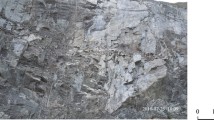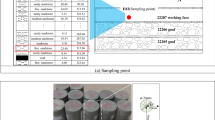Abstract
Based on calculations of rock fracture surface and angle, incremental-load creep experiments were conducted on two groups of major-defect fractured rock specimens in an RLW-2000 rheology test system. The research investigated the fracture type and the creep properties of major-defect fractured rock and analyzed the relationships between failure load and horizontal or vertical projection distance, and between each of theme and fracture area or angle. The results showed that rock fracture was divided into three types according to the distribution, including I, II, and III types. I, II, and III types were respectively an internal fracture running through neither the upper nor lower end, one through the upper or lower end and one through both upper and lower ends, and a III type was further sub-divided into IIII and IIIII types. The instantaneous strain was larger than the creep strain under the same creep loading stage. As the creep loading increased on two groups of major-defect fractured rock, the instantaneous strain decreased abruptly and then increased abruptly, while the creep strain decreased rapidly at first and later increased near-linearly. When the failure angle was larger than the friction angle, failure load was positively correlated with failure angle yet was negatively correlated with vertical projection distance. Vertical projection distance and fracture angle, which decided fracture type, controlled rock failure load. Failure load increased in turn from I type to III type, and low-type fracture determined mainly failure load in multiply-fracture specimen.














Similar content being viewed by others
References
Alber M, Heiland J (2001) Investigation of a limestone pillar failure part 2: stress history and application of fracture mechanics approach. Rock Mech. Rock Engng 34(3):187–199
Chong SH, Kim JW, Cho GC (2014) Rock mass dynamic test apparatus for estimating the strain-dependent dynamic properties of jointed rock masses. Geotech Test J 37(2):311–318
Dai F, Wei MD, Xu NW, Ma Y, Yang DS (2015) Numerical assessment of the progressive rock fracture mechanism of cracked chevron notched Brazilian disc specimens. Rock Mech. Rock Engng 48:(2):463–(2):479
Feng ZC, Zhao YS (2008) Control effect of fissure scale on deformation and failure of rock mass. Chin J Rock Mech Eng 27(1):78–83
Fan X, Kulatilake PHSW, Chen X, Cao P (2015) Crack initiation stress and strain of jointed rock containing multi-cracks under uniaxial compressive loading: a particle flow code approach. J Cent South Univ 22(2):638–645
Funatsu T, Shimizu N, Kuruppu M, Matsui K (2015) Evaluation of mode I fracture toughness assisted by the numerical determination of K-resistance. Rock Mech. Rock Engng 48(1):143–157
Gao YF, Qu ZJ, Niu XL (2007) Rheological law for softrock tunnel and evolution law for stress field in deep mine. J China Coal Soc 32(12):1244–1252
Hadi H, Kourosh S, Mohammad FM, Parviz M (2014) Investigating the fracturing process of rock-like Brazilian discs containing three parallel cracks under compressive line loading. Strength Mater 46(3):133–148
Jambunathan L (2014) Stress strain behavior of clayey sand. Electron J Geotech Eng 19:775–780
Kuwano R, Jardine R (2011) On measuring creep behaviour in granular materials through triaxial testing. Can Geotech J 39(5):1061–1074
Ladanyi B, Benyamina MB (2011) Triaxial relaxation testing of a frozen sand. Can Geotech J 32(3):496–511
Li L, Zhang X (2015) A new triaxial testing system for unsaturated soil characterization. Geotech Test J 38(6):823–839
Masoumi H, Saydam S, Hagan PC (2015) A modification to radial strain calculation in rock testing. Geotech Test J 38(6):813–822
Nixon JF, Lem G (2011) Creep and strength testing of frozen saline fine-grained soils. Can Geotech J 21(3):518–529
Salazar SE, Bames A, Coffman RA (2015) Development of an internal camera-based volume determination system for triaxial testing. Geotech Test J 38(4):549–555
Tan X, Konietzky H, Frühwirt T (2015) Numerical simulation of triaxial compression test for brittle rock sample using a modified constitutive law considering degradation and dilation behavior. J Cent South Univ 22(8):3097–3107
Vergara MR, Kudella P, Triantafyllidis T (2015) Large scale tests on jointed and bedded rocks under multi-stage triaxial compression and direct shear. Rock Mech. Rock Engng 48(1):75–92
Wang LL, Bornert M, Héripré E, Chanchole S, Pouya A, Halphen B (2015) The mechanisms of deformation and damage of mudstones: a micro-scale study combining ESEM and DIC. Rock Mech Rock Engng 48(5):1913–1926
Wei SJ, Gou PF, Yu CS (2013) Creep simulation on fractured surrounding rock of large section chamber and its control technology. Journal of Mining and Safety Engineering 30(4):489–494
Zhang K, Cao P, Meng JJ, Li KH, Fan WC (2015) Modeling the progressive failure of jointed rock slope using fracture mechanics and the strength reduction method. Rock Mech. Rock Engng 48(2)):771–785
Zhou J, Chen M, Jin Y, Zhang GQ (2008) Analysis of fracture propagation behavior and fracture geometry using a tri-axial fracturing system in naturally fractured reservoirs. Int J Rock Mech Min 45(7):1143–1147
Zhu SY, Liu RX, Zhang SJ, Hu DX (2016) Characteristics of deformation and failure of deep coal seam floor affected by fully mechanized mining. Geotech Test J 39(1):1–12
Acknowledgments
This work was financially supported by key project of science and technology research in Henan Province Education Department (14B440001) and key project of science and technology research in Jiaozuo City (20151021103453).
Author information
Authors and Affiliations
Corresponding author
Rights and permissions
About this article
Cite this article
Xin, Y., Li, M., An, D. et al. Experimental study on the instability mechanism of the major-defect fractured rock. Arab J Geosci 10, 311 (2017). https://doi.org/10.1007/s12517-017-3095-9
Received:
Accepted:
Published:
DOI: https://doi.org/10.1007/s12517-017-3095-9




